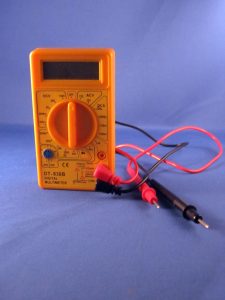Conductivity Detectives … Scavenger Hunt

Author(s): Seth Bush
Subject: Physics
Grade Level(s): Grade 4
Big Idea(s):
- Students know electric currents produce magnetic fields and know how to build a simple electromagnet.
- Students know the role of electromagnets in the construction of electric motors, electric generators, and simple devices, such as doorbells and earphones.
- Formulate and justify predictions based on cause-and-effect relationships.
- Conduct multiple trials to test a prediction and draw conclusions about the relationships between predictions and results.
- Construct and interpret graphs from measurements.
- Follow a set of written instructions for a scientific investigation.
- Students know magnetic materials and electric currents (moving electric charges) are sources of magnetic fields and are subject to forces arising from the magnetic fields of other sources.
What you need: • Electrical conductance meter
• Test Samples, See table on attached lesson, Some Examples include:
• Copper
• Tin Strips
• Graphite Rods
• Silicon Chunk
• Cardboard Strips
• Glass Rod
• A pen
Setting: Classroom
Time Needed: Teacher’s Discretion
Summary:
In this activity you will measure the electrical conductivity of a series of materials using a simple conductivity meter. You will use your observations to try to come up with conductivity trends. Understanding conductivity is an essential element of DC circuits and electromagnets.
Learning Goals / Objectives:
1. Materials can be conductors, semiconductors or insulators (nonconductive).
2. Electrical conductors allow electrons to move freely.
3. With some exceptions, metals tend to be conductors, metalloids/semimetals tend to be semiconductors and nonmetals tend to be insulators.
4. Conductivity is not affected by shape.
Background
This activity is relatively bullet proof. Trouble shooting the electrical conductance meter is straight forward. You can test your conductance meter before starting by measuring the conductance of a copper wire and your arm. The copper wire should register as “highly conductive” and your arm should register as “non-conductive”.
Safety
None of the materials used in this exercise pose significant safety risks.
Setup:
Teacher’s Discretion
Anticipatory Set:
Driving Questions
1. What does it mean to be a conductor? Insulator? Semiconductor?
2. In what materials will current flow?
Instructions / Activities:
Use the electrical conductance meter to measure the conductivity of each sample. Touch both electrodes to your sample. The LED will give you a measure of the relative conductivity:
Bright and blinking ~ high conductivity (conductor)
Dim ~ low conductivity (semi-conductor)
Off~ no conductivity (insulator)
Record your findings in your notebook. Find neat things on your own for S-X. Pool your results with two other groups.
Possible Alternatives:
You may want to include solutions as well (tap water, pure water, salt water, sugar water would all be interesting).
Quick follow up questions:
1. What trends did you see?
2. What anomalies did you see?
3. Amorphous carbons and graphite are both forms of carbon. What could explain their electrical conductivity differences (if any)?
4. What roll does the shape of a material seem to play in electrical conductivity?
5. What tips would you give a peer attempting this exercise?
6. What tips would you give a student attempting this exercise?
7. Which substance(s) would make the best electrical wire in a light bulb: Plastic, Glass, Silicon, or Graphite? Justify your answer using specific experimental data.
8. Which substance(s) would make the best insulators to coat a wire in a light bulb: Plastic, Glass, Silicon, or Graphite? Justify your answer using specific experimental data.
Assessment:
Teacher’s Discretion
Wrap-up / Closure:
Practical Application Extension questions:
1.) What materials do you often see in wire? Can you explain why folks use these materials?

